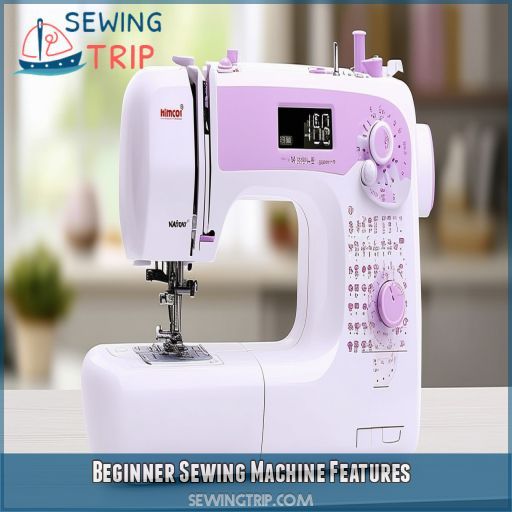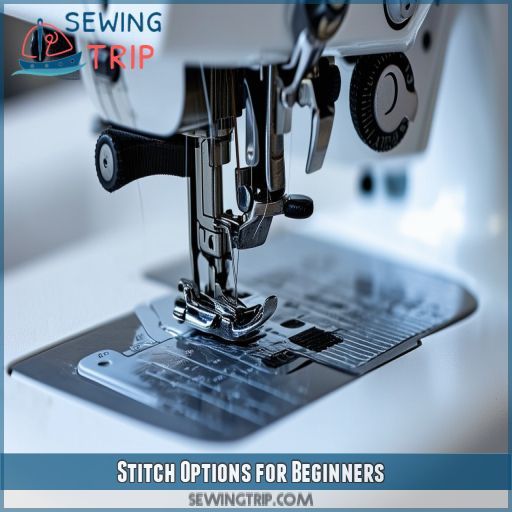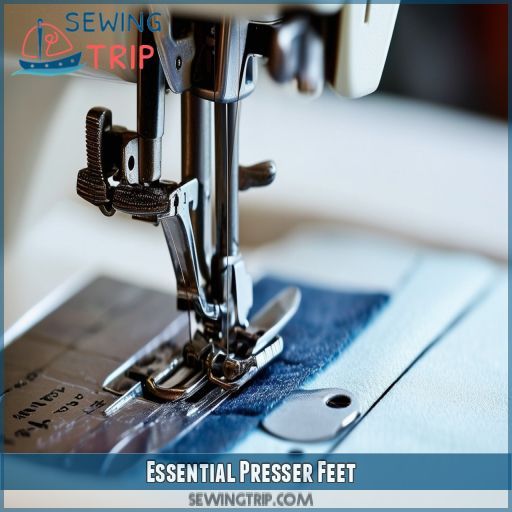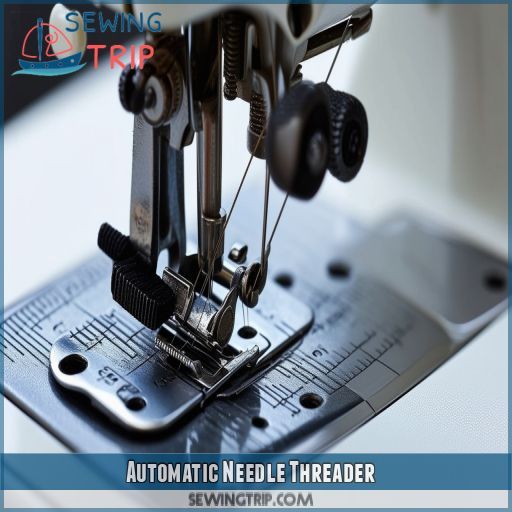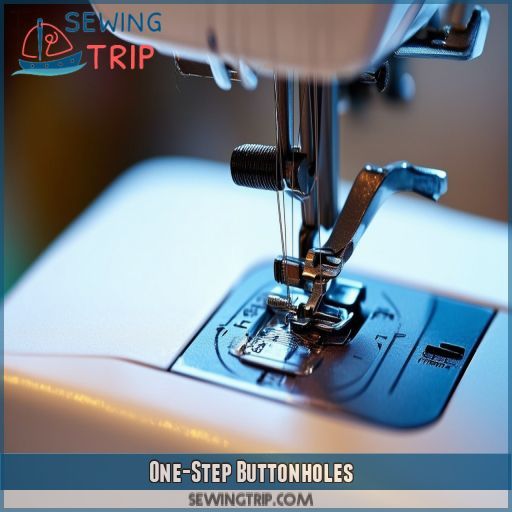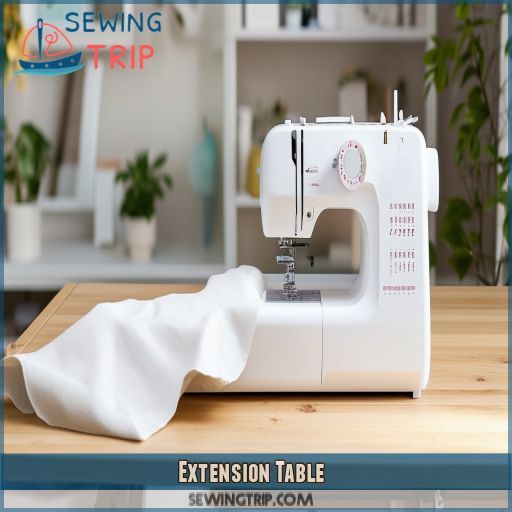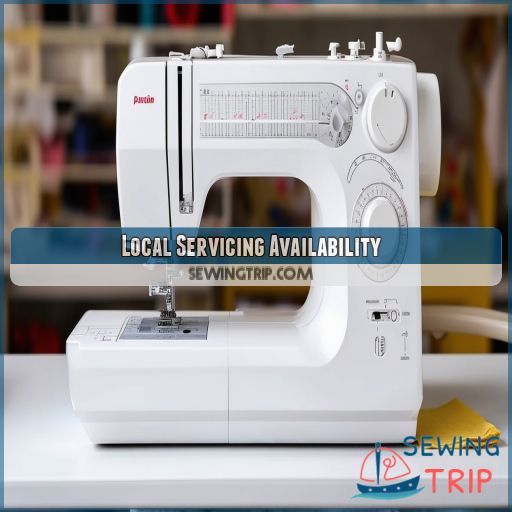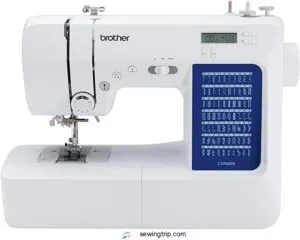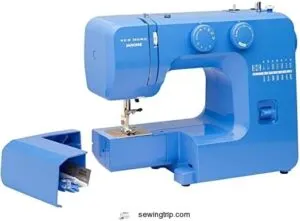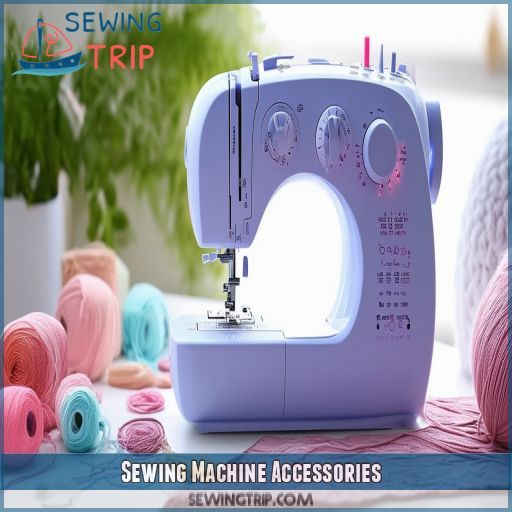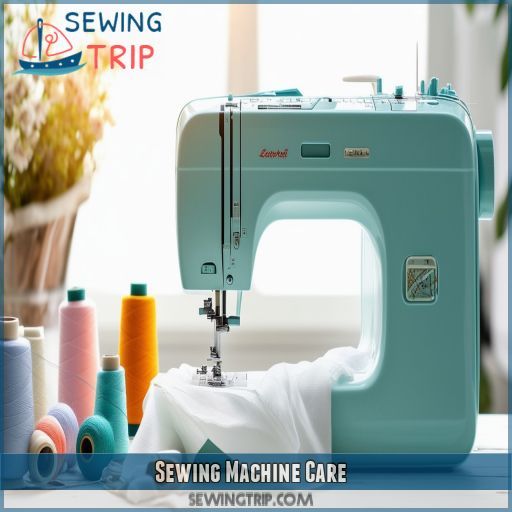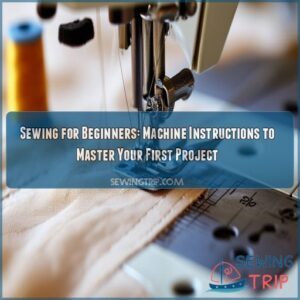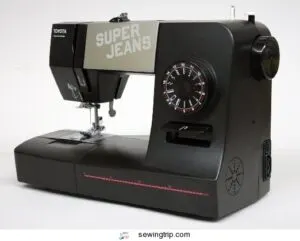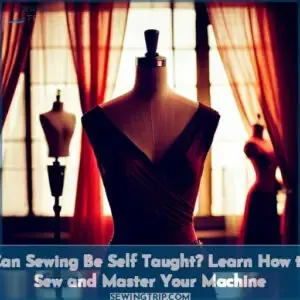This site is supported by our readers. We may earn a commission, at no cost to you, if you purchase through links.
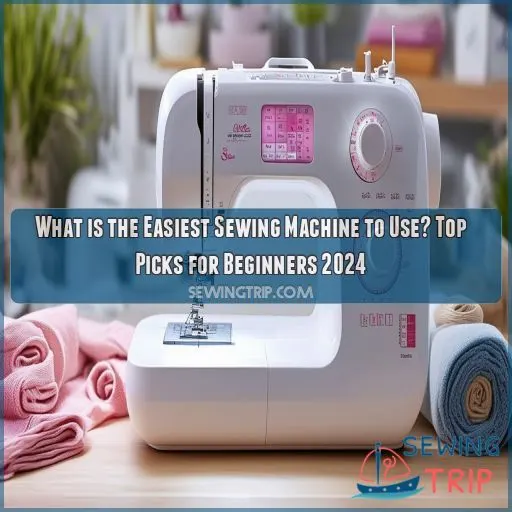 The easiest sewing machine to use is one that matches your skill level and project needs. Look for user-friendly features like automatic needle threading, one-step buttonholes, and clear stitch selection.
The easiest sewing machine to use is one that matches your skill level and project needs. Look for user-friendly features like automatic needle threading, one-step buttonholes, and clear stitch selection.
Beginners often find computerized machines with intuitive interfaces easier to navigate than mechanical models. Drop-in bobbins are typically more straightforward to use than front-loading ones.
Essential stitch options include straight and zig-zag stitches, while decorative stitches add versatility. Don’t forget about presser feet – a general-purpose foot, zipper foot, and buttonhole foot are must-haves.
Table Of Contents
- Key Takeaways
- What is the Easiest Sewing Machine to Use?
- Beginner Sewing Machine Features
- Stitch Options for Beginners
- Essential Presser Feet
- Automatic Needle Threader
- One-Step Buttonholes
- Extension Table
- Local Servicing Availability
- Recommended Beginner Sewing Machines
- Sewing Machine Accessories
- Sewing Machine Care
- Frequently Asked Questions (FAQs)
- Conclusion
Key Takeaways
- The Brother CS7000X is a beloved choice for beginners, offering 70 built-in stitches, an automatic needle threader, and a large workspace. It’s like having a sewing superpower at your fingertips!
- When choosing your sewing machine, don’t be afraid to try them out in-store. It’s like test-driving a car before you buy it. Find one that feels comfortable and intuitive, like a well-fitting glove.
- Regular cleaning and oiling of your sewing machine is like giving it a spa day. It keeps it running smoothly and prevents any nasty surprises down the road.
- Avoid using fabrics like silk or chiffon as a beginner. They’re like slippery ninjas that can make your sewing experience more challenging. Stick to cotton or polyester blends until you’ve mastered the basics.
What is the Easiest Sewing Machine to Use?
The Brother CS7000X Sewing and Quilting Machine is often considered the easiest sewing machine to use due to its user-friendly features. It includes automatic needle threading and an extension table, ideal for beginners.
Beginner Sewing Machine Features
When choosing your first sewing machine, you’ll encounter different types: mechanical, computerized, and sergers. You’ll also need to decide between drop-in and front-loading bobbins, each with their own advantages for beginners.
Mechanical Vs Computerized
When choosing your first sewing machine, you’ll encounter mechanical and computerized options. Mechanical machines offer simplicity and hands-on control, with manual tension adjustments. Computerized models boast automatic features, like tension settings and stitch selection. While mechanical machines are more affordable, computerized ones provide advanced capabilities for those seeking versatility in their sewing projects.
Sergers
While mechanical and computerized machines cover most beginner needs, you might encounter sergers. These specialized machines finish garments, trim fabric, and create overlock stitches. They’re faster but trickier to thread and adjust. For beginners, stick with standard machines until you’re comfortable. Later, a serger can elevate your sewing game.
Drop-in Vs Front-loading Bobbins
When choosing your first sewing machine, consider bobbin type. Drop-in bobbins are top-loading and user-friendly, ideal for beginners. Front-loading bobbins, found in bottom-loading machines, offer easier tension checks. For quilters and embroidery enthusiasts, drop-in bobbins are often preferred in best budget and entry-level machines for their simplicity and ease of use.
Stitch Options for Beginners
When you’re starting out, you’ll want to focus on mastering straight and zig-zag stitches, which are the foundation for most sewing projects. As you gain confidence, you can explore decorative and buttonhole stitches to add flair to your creations and learn essential garment-making techniques.
Straight and Zig-Zag Stitches
You’ll find straight and zig-zag stitches on every beginner-friendly sewing machine. They’re your go-to for most projects. Adjust stitch length and width to suit fabric thickness. Don’t forget to match thread tension, needle size, and presser foot pressure. Master these basics, and you’ll be stitching like a pro in no time!
Decorative Stitches
You’ll love exploring decorative stitches on your new machine. They’re your ticket to unique designs and custom projects. With a variety of patterns at your fingertips, you can add flair to garments, create eye-catching embellishments, and even craft intricate borders. It’s like having a built-in artist for your fabric!
Buttonhole Stitches
You’ll find buttonhole stitches essential for garment-making. Most computerized sewing machines offer various buttonhole styles and a one-step process for consistent quality. If you’re troubleshooting buttonholes, check that you’re using the right accessories. Mechanical machines may require more practice, but they’re still capable of producing great results. Don’t hesitate to purchase online from reputable sellers.
Essential Presser Feet
You’ll want to familiarize yourself with three essential presser feet for your sewing machine: the general-purpose foot, zipper foot, and buttonhole foot. These attachments will allow you to tackle a wide range of basic sewing projects with ease and precision.
General-Purpose Foot
When choosing your first sewing machine, you’ll want to focus on stitch options and essential presser feet. The general-purpose foot is your go-to for most projects. It’s versatile enough to handle various fabric types and stitch lengths. Adjust your needle size and thread tension accordingly for the best results.
Zipper Foot
You’ll love the versatility of a zipper foot! It’s your go-to for zipper attachment and installation. Whether you’re sewing an invisible zipper or adding a decorative zipper, this nifty tool keeps your stitches close to the teeth. It’s a game-changer for clean, professional-looking zipper projects.
Buttonhole Foot
You’ll love the buttonhole foot for creating professional-looking buttonholes effortlessly. It guides your machine to sew perfect buttonholes every time. Here’s what you need to know:
- Adjusts for different buttonhole sizes
- Guarantees precise buttonhole placement
- Allows for various buttonhole shapes and types
Say goodbye to stress and hello to flawless buttonholes!
Automatic Needle Threader
You’ll appreciate the automatic needle threader feature, which saves time and reduces eye strain when setting up your machine. This handy tool guides the thread through the needle’s eye, making it easier for beginners to start sewing quickly and efficiently.
Time-Saving Feature
You’ll love the automatic needle threader feature on modern sewing machines. It’s a game-changer, saving you time and frustration. Here’s how it compares to manual threading:
| Aspect | Manual Threading | Automatic Threader |
|---|---|---|
| Time | 1-2 minutes | 10-15 seconds |
| Ease | Challenging | Effortless |
| Precision | Varies | Consistent |
| Learning | Steep curve | Quick to master |
| Stress | High | Minimal |
This nifty feature works with various needle sizes and fabric types, ensuring proper thread tension. It’s especially handy when switching between different presser foot pressures or automatic bobbin systems.
Reduces Eye Strain
You’ll love the automatic needle threader on modern sewing machines. It’s a game-changer, especially if you’ve struggled with threading needles in the past.
This nifty feature reduces eye strain by doing the hard work for you. No more squinting or fumbling with tiny needle eyes!
You’ll save time and frustration, making your sewing experience much more enjoyable.
With just a simple lever or button press, your needle is threaded, and you’re ready to start stitching. It’s like having a mini-assistant right at your fingertips!
One-Step Buttonholes
You’ll find one-step buttonholes incredibly helpful as a beginner sewer. This feature allows you to create perfectly sized and spaced buttonholes with just one step, ensuring consistent results every time.
Consistent Results
You’ll love the consistent results you get with one-step buttonholes. No more wonky, uneven buttons!
These nifty features take the guesswork out of sizing and spacing, ensuring each buttonhole is picture-perfect.
Whether you’re working with delicate silk or sturdy denim, just set your bobbin tension and needle size correctly, and you’re good to go. Remember, matching your thread choice to your fabric type is key.
With one-step buttonholes, you’ll nail that professional look every time, even with tricky seam allowances.
Easy to Use
You’ll love one-step buttonholes on beginner-friendly sewing machines. This feature takes the guesswork out of creating perfect buttonholes every time. With user-friendly controls and intuitive design, you’ll be sewing like a pro in no time. Simply select the buttonhole stitch, and the machine does the rest.
- Automatic stitch selection ensures consistent results
- Simple threading saves time and frustration
- Easy-to-use interface lets you focus on your project
These machines are designed with you in mind, making your sewing journey a breeze. You’ll feel like part of the sewing community in no time!
Extension Table
An extension table provides a stable surface for your fabric, making it easier to handle larger projects like quilts or dresses. You’ll appreciate the extra workspace and the ability to use a ruler for precise measurements, ensuring your sewing projects turn out just right.
Provides Stable Surface
You’ll love having an extension table on your sewing machine. It provides a stable surface that’s a game-changer for your projects.
With even weight distribution, your fabric stays put, making it easier to handle larger pieces. The extended work area gives you more room to maneuver, especially when tackling quilts or bulky items.
It’s like having an extra pair of hands! Plus, the smooth surface ensures your stitches stay straight and true.
You’ll wonder how you ever sewed without one.
Allows for Ruler Use
An extension table on your sewing machine isn’t just for show. It’s a game-changer for your sewing projects. You’ll appreciate the even weight distribution it provides, making your fabric glide smoothly as you work. Plus, it’s perfect for ruler use, allowing you to measure and mark with precision. Here’s what you can do with an extension table:
- Create perfectly straight seams on long pieces
- Quilt larger projects with ease
- Measure and cut fabric directly on the machine
- Keep small notions within arm’s reach
- Fold it away for compact storage when not in use
Local Servicing Availability
When choosing a sewing machine, consider the availability of local servicing options. Having a nearby repair shop or dealer can help keep your machine in top condition and extend its lifespan through proper maintenance.
Important for Maintenance
While an extension table‘s a handy feature, don’t overlook the importance of local servicing. You’ll want a machine that’s easy to maintain, with accessible repair options nearby.
Whether you’re dealing with bobbin issues or tension adjustments, having a local expert can be a lifesaver. They’ll keep your needle threader in top shape and help you troubleshoot any hiccups.
Ensures Long Machine Life
Regular maintenance is key to ensuring your sewing machine’s longevity. When you’ve got local servicing available, you’re not just maintaining your machine; you’re protecting your investment.
A well-maintained machine with proper bobbin placement and thread tension will serve you faithfully for years. You’ll appreciate features like automatic needle threaders and extension tables even more when they’re working smoothly.
Don’t forget to adjust stitch length as needed and keep your machine clean. With proper care, your sewing companion will be by your side for countless projects to come.
Recommended Beginner Sewing Machines
You’ll find the Brother CS7000X Sewing and Quilting Machine and the Janome Blue Couture Sewing Machine are top picks for beginners. These machines offer user-friendly features and versatile functions that make learning to sew easier and more enjoyable.
1. Brother CS7000X Sewing and Quilting Machine
You’ll love the Brother CS7000X for its beginner-friendly features. With 70 built-in stitches, you’re set for any project.
The improved automatic needle threader saves time and reduces eye strain, while one-step buttonholing ensures professional results.
A large workspace gives you room to maneuver, perfect for quilting. The LCD display and intuitive controls make operation a breeze.
Plus, with 10 presser feet and a hard case included, you’re ready to start sewing right out of the box.
2. Janome Blue Couture Sewing Machine
If you’re looking for a simple yet capable machine, the Janome Blue Couture is a great choice. This beginner-friendly model boasts 15 built-in stitches and a 4-step buttonhole, giving you versatility without overwhelming options.
Its sturdy metal frame guarantees durability, while the front-loading bobbin system offers easy access. You’ll appreciate the adjustable stitch length and zigzag width, allowing for customization as your skills grow.
With a removable free arm and included accessories, you’re set for a range of projects.
Sewing Machine Accessories
To get the most out of your new sewing machine, you’ll need a few essential accessories. These include needles, thread, scissors, pins, and a seam ripper, which will help you tackle a variety of sewing projects with ease.
Needles
You’ll need the right needles for your projects. From universal to ballpoint and stretch needles, each type serves a purpose. Don’t forget about needle sizes and twin needles for decorative stitching!
Thread
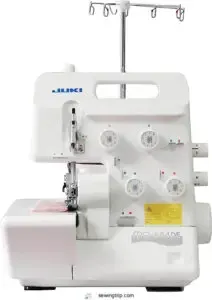
You’ll need quality thread for your sewing projects. Consider these factors when choosing:
- Bobbin type compatibility
- Stitch length requirements
- Presser foot type
Proper thread tension is critical for neat stitches. Adjust as needed for different fabrics.
Scissors
You’ll need quality scissors for your sewing projects. Here’s a quick guide to help you choose:
| Type | Use | Sharpening | Storage |
|---|---|---|---|
| Fabric | Cutting cloth | Yearly | Sheath |
| Embroidery | Fine details | Rarely | Case |
| Pinking | Seam finishing | As needed | Drawer |
| Thread snips | Quick cuts | Replace | Magnetic holder |
Pins
You’ll need pins for your sewing projects. They’re essential for marking, holding, and decorating fabric. Here are some pin types you’ll encounter:
- Glass head pins
- Quilting pins
- T-pins
- Ball-point pins
- Silk pins
Seam Ripper
You’ll need a seam ripper to fix mistakes. This handy tool comes in various sizes and shapes. Here’s a quick guide to help you choose:
| Feature | Options | Importance |
|---|---|---|
| Size | Small, Medium, Large | Affects precision |
| Grip | Plastic, Ergonomic, Cushioned | Impacts comfort |
| Cost | Budget, Mid-range, Premium | Reflects quality |
Sewing Machine Care
To keep your sewing machine running smoothly, you’ll need to clean and oil it regularly, store it properly, and avoid common causes of damage. Regular maintenance will extend your machine’s life and guarantee consistent performance, so make it a habit to care for your sewing companion.
Cleaning and Oiling
Now that you’ve got your accessories, let’s talk about keeping your sewing machine in top shape. Regular cleaning and oiling are vital for smooth operation. Establish a cleaning schedule and use the right oil type and frequency. Here are some key points:
- Brush away lint to prevent frustrating jams
- Oil moving parts for satisfying, whisper-quiet sewing
- Clean the bobbin area to guarantee flawless stitches
Proper Storage
After cleaning, proper storage is essential. Keep your machine in a cool, dry place away from direct sunlight. Use a dust cover to protect it from debris. For space-saving storage options, consider a dedicated sewing cabinet or a portable carrying case. These solutions help your machine remain in optimal condition between uses.
Avoiding Damage
To keep your sewing machine running smoothly, avoid these common issues:
- Bobbin tension problems
- Poor stitch quality
- Frequent needle breakage
- Frustrating thread jams
Choose the right fabric for your machine’s capabilities. Regular maintenance and proper use will prevent most problems, ensuring you’ll enjoy many years of trouble-free sewing.
Frequently Asked Questions (FAQs)
What is the best easy to use beginner sewing machine?
Imagine threading your first machine with ease. The Brother CS7000X is an excellent choice for beginners. It’s user-friendly, versatile, and packed with features like an automatic needle threader. You’ll be sewing confidently in no time.
Which sewing machine has the least problems?
You’ll find the Brother CS7000X has the fewest issues. It’s reliable, user-friendly, and versatile. With automatic features and clear instructions, you’ll breeze through projects. Regular maintenance will keep it running smoothly for years to come.
How to choose a sewing machine for beginners?
Choose a beginner-friendly sewing machine with essential features like straight and zigzag stitches. Look for automatic threading, adjustable speed, and a front-loading bobbin. Consider your budget and sewing goals. Try machines in-store to find one that feels comfortable.
Can a beginner use a computerized sewing machine?
Like a gentle breeze guiding your fabric, computerized sewing machines can be perfect for beginners. You’ll find them user-friendly, with automatic features that simplify tasks. They’re versatile tools that grow with your skills, making your sewing journey smoother.
Which sewing machine is best for a beginner?
For beginners, the Brother CS7000X is an excellent choice. It’s user-friendly, versatile, and packed with features like 70 built-in stitches and an automatic needle threader. You’ll find it easy to learn and grow with as your skills improve.
What is the best sewing machine for quilting?
If you’re diving into quilting, the Janome 4120QDC-G is your best bet. With features like a thread cutter, memory function, alphabetical stitches, and 15 needle positions, it’s a quilter’s dream come true.
What is the best Brother Sewing Machine for beginners?
The Brother CS7000X is the best beginner machine due to its 70 built-in stitches, user-friendly interface, and included accessories, making it versatile and intuitive, especially for those just starting their sewing journey.
What is the fastest sewing machine?
The Juki TL2010Q is lightning in a bottle, boasting speeds up to 1,500 stitches per minute. This heavy-duty machine is a workhorse, perfect for tackling large projects swiftly and with precision.
How long does it take to learn sewing?
Learning to sew can take a few weeks for basic skills if you practice regularly. Start with simple projects, follow detailed instructions, and be patient. With consistent practice, you’ll improve and tackle more complex sewing tasks.
Can I sew leather on a beginner machine?
Though it’s tempting to commence, sewing leather on a beginner machine isn’t recommended. The material is tough as nails, demanding a heavy-duty machine with a strong motor and specialized needles for smooth stitching.
What fabrics should beginners avoid when starting out?
As a beginner, avoid fabrics like silk, chiffon, and satin. They’re slippery and hard to handle. Instead, start with cotton or polyester blends. These are much more forgiving, allowing you to practice and build confidence.
How often should I oil my sewing machine?
Oil your sewing machine every 8 to 10 hours of use, or once a month if used infrequently. Regular lubrication guarantees smooth operation, prevents rust, and extends the machine’s lifespan. Always refer to the manual for specifics.
Are vintage sewing machines suitable for beginners?
Vintage sewing machines can work well for beginners, but may require more maintenance and lack modern conveniences. Consider a newer, user-friendly model with features like automatic needle threaders and one-step buttonholes to simplify the learning process.
Conclusion
Notably, around 50% of beginners find computerized machines easier to use. When considering what’s the easiest sewing machine to use, bear in mind to prioritize features that align with your needs, such as user-friendly interfaces and essential presser feet.
Options like the Brother CS7000X or Janome Blue Couture will facilitate your smooth start to your sewing journey.
Regular maintenance, availability of accessories, and local servicing help to guarantee your machine remains in optimal condition for years. Enjoyable sewing!
- stitchers-source.com

